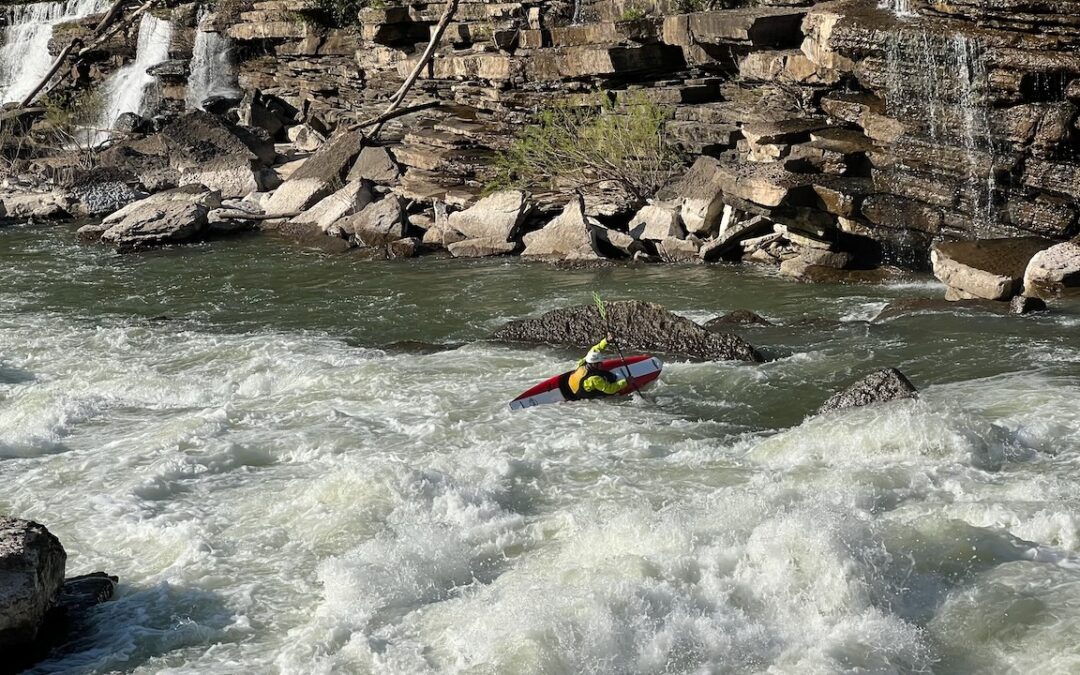Tip of the Day for Preparing for the 2025 Paddling Season- Start with the basics- learn your foundational skills- Step 1- Learn and Practice Strokes and Concepts. The nice thing about strokes and concepts is that you can learn the flatwater drills in a swimming pool, or any non-frozen body of water. On a cold day, you can stay dry, wear gloves, a hat, etc. and still learn the skills. At the risk of sounding demeaning, most (99% )of paddlers do not have a quiver of effective strokes. The fun factor and your performance factor will improve dramatically with learning and mastering the basics. My YouTube Channel has my entire program broken down into individual strokes. It is amazing how after mastering them in flatwater, you begin to naturally apply them to the whitewater. Of course, there is an entire set of drills, etc.. that you can do to fully grasp and master the whitewater “concepts” part of the program where you apply your strokes to the whitewater. Think of the program as an ongoing learning experience, like martial arts. Most kayakers think of it like you take your first karate class and go home, saying, “I learned how to do Karate today, let me show you how you do it.” While we are all at some level in our specific skills and knowledge, only by assuming we are still not doing things nearly as well as we could, and desiring to learn more, do we keep the progress going. I personally think it adds an additional fun factor to the social side, the “get out in the outdoors” side, the “fitness” side, and all of the other benefits of our sport.
Intro: What does Strokes and Concepts consist of?
- You only have 4 things that you have control over to move your kayak to where you want it to go- your head, paddle, boat, and body. Learning the habits of each for different strokes to achieve different movements with your boat that are the most effective, is what it is all about.
- Using the Water and physics- The concepts of Speed, Angle, Arc, and Spin Momentum are ones that you will want to understand, learn to use, and ultimately have become second nature.
“EJ’s 12-Minute Stroke Drill Warm-Up Program- One of the most important things I brought to my paddling and share with others. This is a 1-2 punch. 1. it is the ideal warm-up for your body to get it ready for action. It is what I do before every World Championships ride, before a slalom race, an extreme race, or a day on the river. Every active sport and athlete has some warm-ups that prepare you and help avoid injury. This specific sequence gets your upper body, hip flexors, etc. ready for action. 2. It is how you make your Strokes and Concepts a habit. During your warm-up, you will practice each stroke, being able to improve them, and commit to memory. By doing this warm-up every time you paddle, you will start to apply the proper head, paddle, boat, and body movements/positions to your whitewater day and your effectiveness on the water will improve, your boat control will improve, your speed of moving the boat around with less energy will improve. Video below:
If you and I are in the same type and size boat, and we paddle forwards with the same stroke rate, chances are I’ll be quite a bit faster than you are. This is something that should make anyone say, “Huh… I need to work on my forward stroke.” While this is just one stroke, it is one of the hardest to master because, like every stroke, you have to learn to control your head, paddle, boat, and body all at the same time, but independently. It is the stroke most people think of working on, but most people have not learned to separate their head from their torso, their torso from their hips, and don’t have the paddle positions that are most effective. The combination of all of that is a stroke that moves the boat, but at a slower speed, with more energy. However strong or weak you are, you can go faster with less effort. You can go at “X” speed longer without getting tired, etc.. There are a lot of nuances to the forward stroke, and a ton of misconceptions. Below, I’ll break it down for you. (FYI- a whitewater kayak’s stroke is different from a sea kayak, or a flatwater racing kayak, or a surf ski, etc.. )
Your Primary Turning Strokes- Sweeps- the forward sweep is “so easy” but the ACA, British Canoe Union, etc. etc. teach it incorrectly and put you at a disadvantage. This has been going on since the 70’s and has not improved, so it has reached critical mass and almost every paddler learns how to do the forward sweep incorrectly. The chances are, you have some very bad habits to overcome with this stroke. The good news is that doing it correctly is easy, but you’ll need a lot of flatwater practice to overcome the 1,000’s of sweeps you have already done to develop. your current habits.
Another important “Primary turning stroke” that is “easy” but you are likely lazy in the stroke and consequently are not effective enough with it to be good at squirting and other moves that require and effective reverse sweep. Learn what to focus on so that your habits are good, so when you are trying something in whitewater, and can’t focus on your paddle position, you nail it automatically.
Your kayak goes forwards and backwards and most kayakers are not very effective going backwards. Is this is problem? Well, yes, of course it is, “you either can or can’t” and you want to be someone who can. If you are approaching a hard rapid and in the middle of the river at a horizon line and need to get close enough to see, if you are good at going backwards, you can approach, and back paddle to maintain position, ferry either way without thinking about it to position yourself while you boat scout. If you struggle to keep the boat straight when back paddling, you’ll just turn around and point upstream, trying to unsuccessfully look over your shoulder, eventually have to go to shore or find an eddy. That is just one example of course. Be the kayaker who can.
Your first “Concept” that applies 100% of the time that you are moving the boat, even in flatwater. You can’t escape its grasp- spin momentum is with you always and either it is a random force that works for you 50% of the time and against you the other times, or you harness it to make your boat move more effectively and control it with ease. You know how a beginner can’t paddle a boat straight for very long? That is spin momentum that gets them and overpowers them and spins them out. While you learn to “paddle straight” in you first day, learning to harness it always is something that few take the time to do. Learn it here.
Draw stroke- another stroke that’s name “draw, duffek, etc.” are thrown around, but taught incorrectly and the entire purpose of it is lost, and the effect of one done properly is never experienced by most paddlers. Did you know that on average, if a kayaker were to do a turn around the back of another paddlers kayak in flatwater making a 180 degree turn, it would take them 5 strokes to do the turn and come back around to the bow of their friend’s boat? 5 strokes is the international average over the past 40 years. When I do the same drill, using the draw stroke properly, I do it in one stroke, and come out of that turn with more speed and control than the average person in 5 strokes. 5 to 1 ratio, and faster with more control. That is such a massive difference in effectiveness, simply by learning to carry your forward momentum around a turn, versus sliding out and losing it and having to power around a turn like a car on a dirt track. The effect of this same stroke, done properly in conjunction with proper use of Speed, Angle, Arc, and Spin Momentum in whitewater, and its effect in whitewater is equally (more) notable. Simply put, learn it, and don’t expect that your instructor knows it. There is a test I do that allows you do see where you are with that stroke. Watch the video.
Test Video:
Your First Compound Stroke! The “C Stroke”. This is how you propel yourself forward while turning the boat at the same time. With little Dane, Jason Craig on comedy…
Getting pretty advanced now- We are doing some “compound strokes” that combine strokes you have already learned- Forward sweep and draw, but we are now learning to “feather” the paddle into sweep position again without taking it out the water. Paddle Dexterity is something you are learning and feathering is another big step in that process. Let’s get to it.
Hey, here is a C1 stroke. Why learn to do the offside C stroke like a C1er? Well, it is a paddle dexterity, spin-momentum exercise and if you can’t do it, you suffer from the lack of one or both of those skills, and you don’t want to be accused of that! Also, break a blade off? No problem, you can get down the river still.
Another spin momentum paddle dexterity exercise that allows you to go around stuff without having to turn… pretty cool.
OK, here is a tough one to learn- paddling backwards with one blade in circles, gliding on the draw, feathering, etc.. however, you WILL learn it fairly quickly if you practice it and if you don’t know it, you can’t paddle backwards on one blade! This stroke really gets you familiar with paddle dexterity, gets you used to going backwards, and ultimately will allow you to start peeling out of Eddys backwards, etc..
OK- WHITEWATER- Yea!! I have not filmed the application to whitewater in my new Apex boats yet, so we’ll do a bit of history here in Costa Rica. Here is how to do the Peel out and Eddy out in Whitewater, applying your draw stroke that you just learned.
A Great drill to really dial in your peel outs and eddy outs… Watch Dane, Billy Harris, Emily, Nick, Ruth Gordon, Jessie, Mario, Judd,
Reverse Peel Outs- Putting your reverse compound stroke to work:
Just for fun… Rock Spins- See Mario in action!
I hope you had fun with this one! Sorry there is so much content, but bookmark this blog so you can reference it when you need to.
🙂
EJ

